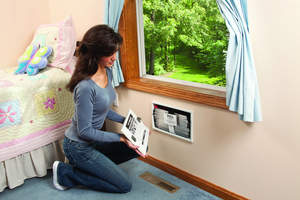MISSION, KS--(Marketwire - October 11, 2010) - (Family Features) In 2008, fire departments responded to 403,000 home fires in the United States, yet, a recent survey by the Home Safety Council (HSC) reveals that less than half (37 percent) of respondents have taken any actions to prevent home fires. In response, HSC and Werner Ladder are partnering to encourage families to prepare for a home fire by developing an emergency escape plan and to make sure second- and third- story exits are equipped with fire escape ladders. Families may consider an innovative built-in ladder as an option.
"If your primary exit is blocked by smoke, heat or flames, you'll need to use a second way out, possibly a window," said Chris Filardi, Senior Vice President of Marketing at Werner Ladder. "Making sure everyone knows the exit options and how to use a built-in fire escape ladder if necessary could, ultimately, save a life in an emergency."
There are more than 70 million two-to-three-story homes in the United States, according to a 2007 U.S. Census Bureau American Housing Survey, yet surprisingly, research by HSC reveals that only six percent of U.S. homes own a fire escape ladder.
"Many families don't realize that a fire can go from first spark to deadly levels in as few as three minutes, leaving families little time to escape," said Home Safety Council President Meri-K Appy. "In situations when getting out of the home quickly is critical to survival, a fire escape ladder may be one of the most important home improvement steps a caregiver can take."
The HSC and Werner Ladder are urging families to work together to develop a fire escape plan. They can start by drawing a floor plan of their home, including all rooms, windows, doors, stairways, fire escapes and smoke alarms, and indentifying two ways out of every room. In some cases a window may be the only way to escape a fire. In this situation, families should have a fire escape ladder that is easy to use and is long enough to reach the ground.
Once the plan is in place, it is just as important that families practice fire drills at least twice a year. As part of their fire drill exercises, families should remember to practice deploying the fire escape ladder to the ground. To practice, extend the escape ladder and climb up a few rungs from the bottom. This will give each family member a sense of what it feels like to be on the ladder while preventing an unnecessary fall. Only use the ladder for an exit in an actual emergency.
If you have infants or children too young to escape independently, keep a front facing baby carrier near the window so an adult can escape with the baby and have both hands free to hold the ladder.
To learn more about developing a fire escape plan and choosing a fire escape ladder for a home, visit the Home Safety Council at http://www.homesafetycouncil.org/MySafeHome/msh_wernerladder_w001.asp to Werner Ladder Feature Page and Werner Ladder at www.wernerfireescapeladder.com. By starting to practice fire safety now, families can ensure they will be prepared throughout the year to exit their home safely in the event of a fire.
